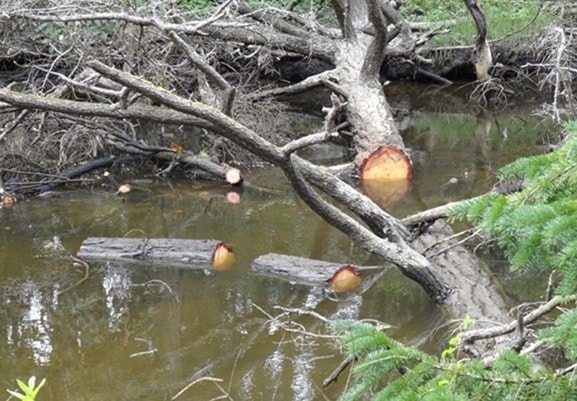Concerned environmental stewards are renewing calls for an environmental authority capable of better enforcing the Gorge Watershed following a bold chainsawing incident on the Colquitz River.
Saanich Police received a report that around 11:30 a.m. on Sunday, a man and a woman were seen paddling a red canoe up the Colquitz River. They used a chainsaw to cut through fallen fir trees that laid across the Colquitz. They are rooted in the bank of Cuthbert Holmes Park, and cutting through them was likely allow access farther up the river for all boaters.
It's not uncommon for various paddlers to cruise up the waters of the Colquitz from Portage Inlet. However, the Colquitz River is a sensitive coho salmon spawning ground and part of the Victoria Harbour Migratory Bird Sanctuary.
Not surprisingly, the destruction of the trees has ticked off an army of activists and volunteers that have given their time to restore the entire Gorge watershed, including the restoration of the salmon-bearing Colquitz.
Despite that, former Canadian Wildlife Services employee Jacques Sirois, who is the chair of the Friends of the Victoria Harbour Bird Sanctuary, believes this is the spark for a much greater, positive conversation.
"We have an amazing thing going here, the Colquitz is truly wild for an urban area, unlike anything in Canada," Sirois said. "There's coho salmon, beaver, mink, river otter. If you paddle through the Colquitz estuary with a chainsaw, that's an insane situation, you can't build this."
Moving forward, it's tough for Saanich to do anything about the tree-cutting incident unless someone comes forward with information about the canoeists, said Eva Riccius, senior manager with Saanich Parks.
"The trees are at least two years old. We found it on a 2013 aerial photo, but who cut this or why, we can't know as no one was caught," Riccius said. "This is a sensitive area and an important river in Saanich, and we ask public to respect wildlife and stay out of that area, it's prime nesting season for birds."
The case file for the cut trees made its way from Saanich Police to Saanich bylaw enforcement and then to Saanich Parks.
The trees were a little ways up the Colquitz past the Dysart Road foot bridge that enters Cuthbert Holmes. As far Saanich is concerned, the fallen trees were within Cuthbert Holmes Park.
But there is a bigger discussion at play here, Sirois contends.
There are signs on display that explain Colquitz is a sensitive habitat for waterfowl. They hang on the bridge upon entry to the estuary, on the new Admirals Bridge, and another on the Dysart foot bridge.
Fallen trees provide crucial shade for fish fry, and can be more important than standing trees, Sirois said.
"You're in a federal migratory sanctuary, you can't be cutting trees here and the fallen trees are even more important than live ones. We need to educate people about this."
It's yet another reason the region needs a proactive authority that can educate the public about the under appreciated wealth of wildlife here, Sirois said.
The Oak Bay resident has sat on the Gorge Waterway Initiative, a conversation forum that brings together the CRD, representatives from five municipalities (including Saanich), the Victoria Canoe and Kayak Club, and many other advocates, including Dorothy Chambers, a successful steward for the Colquitz River.
"As this is a federal migratory bird sanctuary, a coho/chum salmon waterway, and feeding grounds for great blue heron, the alteration of this municipal park riparian large woody debris is a violation under federal, provincial and municipal law," Chambers said.
Chambers and other advocates agree it’s time to ban paddling in the Colquitz, particularly at nesting time. That includes Sirois, a kayaker himself.
However, the matter of canoes and kayaks is somewhat controversial, as the canoe and kayak clubs on the Gorge are dedicated to the cause and have pulled tonnes of garbage out of the Gorge and Colquitz shores.
But use of the Colquitz could be managed better, mitigating damage, Chambers said.
"In 20 minutes on Saturday, six kayakers dug their way up the estuary in three inches of water," Chambers said. "It's a disturbance."
There is a biofilm on the surface of the water that provides nutrition to the waterfowl which is disrupted by boats. Adult fowl also vacate their nests when paddlers come up, leaving them exposed to predators.
Linda Thomson, president of the Victoria Canoe and Kayak Club, said she heard about the incident.
"I don't see why anyone would do it, it's not a good area to paddle," Thomson said.
VCKC has been cleaning up the Gorge since at least 1998 and on April 23 is hosting one of its twice-annual Gorge cleanups.
However, its members do paddle up the Colquitz (though not as far as the cut trees), including small-boat races. But that is changing as VCKC is in the process of finalizing an updated policy with Saanich Parks regarding use of the Colquitz and it's quite restrictive, Thomson said. And the members are certainly made aware of the Colquitz's environmental sensitivity.
“VCKC's new policy refrains from using the Colquitz from November to December during spawning season and from March to June (inclusive) when herons are nesting in Cuthbert Holmes.”
Unfortunately, it's only a club policy and not a public one, Thomson added.
reporter@saanichnews.com
